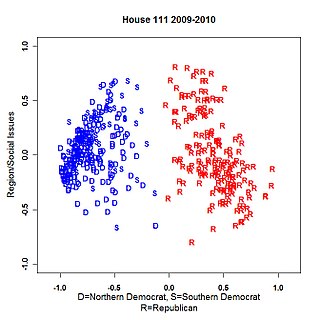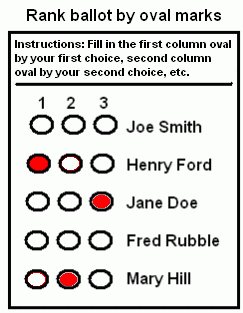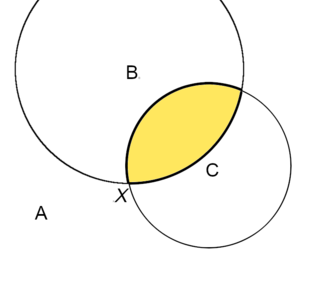Related Research Articles
Plurality voting refers to electoral systems in which a candidate who polls more than any other is elected. In systems based on single-member districts, it elects just one member per district and may also be referred to as first-past-the-post (FPTP), single-member plurality (SMP/SMDP), single-choice voting, simple plurality or relative majority. A system that elects multiple winners elected at once with the plurality rule and where each voter casts multiple X votes in a multi-seat district is referred to as plurality block voting. A semi-proportional system that elects multiple winners elected at once with the plurality rule and where each voter casts just one vote in a multi-seat district is known as single non-transferable voting.

Proportional representation (PR) refers to any type of electoral system under which subgroups of an electorate are reflected proportionately in the elected body. The concept applies mainly to political divisions among voters. The essence of such systems is that all votes cast – or almost all votes cast – contribute to the result and are effectively used to help elect someone – not just a bare plurality or (exclusively) the majority – and that the system produces mixed, balanced representation reflecting how votes are cast.
A political spectrum is a system to characterize and classify different political positions in relation to one another. These positions sit upon one or more geometric axes that represent independent political dimensions. The expressions political compass and political map are used to refer to the political spectrum as well, especially to popular two-dimensional models of it.
Strategic voting, also called tactical voting, sophisticated voting or insincere voting, occurs in voting systems when a voter votes for a candidate or party other than their sincere preference to prevent an undesirable outcome. For example, in a simple plurality election, a voter might gain a better outcome by voting for a less preferred but more generally popular candidate.
The Condorcet paradox in social choice theory is a situation noted by the Marquis de Condorcet in the late 18th century, in which collective preferences can be cyclic, even if the preferences of individual voters are not cyclic. This is paradoxical, because it means that majority wishes can be in conflict with each other: Suppose majorities prefer, for example, candidate A over B, B over C, and yet C over A. When this occurs, it is because the conflicting majorities are each made up of different groups of individuals.

In the comparison of electoral systems, the monotonicity or mono-raise criterion says that ranking a candidate higher on some ballots should not cause them to lose. The monotonicity criterion formalizes the idea that social choice functions and electoral systems should not exhibit "spite" towards some voters, in the sense of actively attempting to frustrate their preferences.

In political science, voter turnout is the participation rate of a given election. This is typically either the percentage of registered voters, eligible voters, or all voting-age people. According to Stanford University political scientists Adam Bonica and Michael McFaul, there is a consensus among political scientists that "democracies perform better when more people vote."
An electoral system satisfies the Condorcet winner criterion if it always chooses the Condorcet winner when one exists. The candidate who wins a majority of the vote in every head-to-head election against each of the other candidates – that is, a candidate preferred by more voters than any others – is the Condorcet winner, although Condorcet winners do not exist in all cases. It is sometimes simply referred to as the "Condorcet criterion", though it is very different from the "Condorcet loser criterion". Any voting method conforming to the Condorcet winner criterion is known as a Condorcet method. The Condorcet winner is the person who would win a two-candidate election against each of the other candidates in a plurality vote. For a set of candidates, the Condorcet winner is always the same regardless of the voting system in question, and can be discovered by using pairwise counting on voters' ranked preferences.
In political science and social choice theory, the median voter theorem states that if voters and candidates are distributed along a one-dimensional spectrum and voters have single peaked preferences, any voting method satisfying the Condorcet criterion will elect the candidate preferred by the median voter.
An independent voter, often also called an unaffiliated voter or non-affiliated voter in the United States, is a voter who does not align themselves with a political party. An independent is variously defined as a voter who votes for candidates on issues rather than on the basis of a political ideology or partisanship; a voter who does not have long-standing loyalty to, or identification with, a political party; a voter who does not usually vote for the same political party from election to election; or a voter who self-describes as an independent.
Peter Carl Ordeshook is an American political scientist. He is the Mary Stillman Harkness Professor of Political Science at the California Institute of Technology in Pasadena, California.
Political forecasting aims at forecasting the outcomes of political events. Political events can be a number of events such as diplomatic decisions, actions by political leaders and other areas relating to politicians and political institutions. The area of political forecasting concerning elections is highly popular, especially amongst mass market audiences. Political forecasting methodology makes frequent use of mathematics, statistics and data science. Political forecasting as it pertains to elections is related to psephology.
A valence issue is an issue where there is a broad amount of consensus among voters. As valence issues are representative of a goal or quality, voters use valence issues to evaluate a political party’s effectiveness in producing this particular goal or quality.
A voting advice application or voting aid application (VAA) or vote matcher or vote compass or election compass is an application that helps voters find a political candidate or political party that stands closest to their preferences. VAAs are a recent phenomenon in modern election campaigning.

NOMINATE is a multidimensional scaling application developed by US political scientists Keith T. Poole and Howard Rosenthal in the early 1980s to analyze preferential and choice data, such as legislative roll-call voting behavior. In its most well-known application, members of the US Congress are placed on a two-dimensional map, with politicians who are ideologically similar being close together. One of these two dimensions corresponds to the familiar left–right political spectrum.
The term issue voting describes when voters cast their vote in elections based on political issues. In the context of an election, issues include "any questions of public policy which have been or are a matter of controversy and are sources of disagreement between political parties.” According to the theory of issue voting, voters compare the candidates' respective principles against their own in order to decide for whom to vote.

The term ranked voting, also known as preferential voting or ranked-choice voting, pertains to any voting system where voters indicate a rank to order candidates or options—in a sequence from first, second, third, and onwards—on their ballots. Ranked voting systems vary based on the ballot marking process, how preferences are tabulated and counted, the number of seats available for election, and whether voters are allowed to rank candidates equally.

The McKelvey–Schofield chaos theorem is a result in social choice theory. It states that if preferences are defined over a multidimensional policy space, then majority rule is in general unstable: there is no Condorcet winner. Furthermore, any point in the space can be reached from any other point by a sequence of majority votes.
Comparison of electoral systems is the result of comparative politics for electoral systems. Electoral systems are the rules for conducting elections, a main component of which is the algorithm for determining the winner from the ballots cast. This article discusses methods and results of comparing different electoral systems, both those that elect a unique candidate in a 'single-winner' election and those that elect a group of representatives in a multiwinner election.
Impartial culture (IC) or the culture of indifference is a probabilistic model used in social choice theory for analyzing ranked voting method rules.
References
- 1 2 Tideman, T; Plassmann, Florenz (June 2008). "The Source of Election Results: An Empirical Analysis of Statistical Models of Voter Behavior".
{{cite journal}}: Cite journal requires|journal=(help) - 1 2 Alós-Ferrer, Carlos; Granić, Đura-Georg (2015-09-01). "Political space representations with approval data". Electoral Studies. 39: 56–71. doi:10.1016/j.electstud.2015.04.003. hdl: 1765/111247 .
the underlying political landscapes ... are inherently multidimensional and cannot be reduced to a single left-right dimension, or even to a two-dimensional space. ... From this representation, lower-dimensional projections can be considered which help with the visualization of the political space as resulting from an aggregation of voters' preferences. ... Even though the method aims to obtain a representation with as few dimensions as possible, we still obtain representations with four dimensions or more.
- 1 2 Davis, Otto A.; Hinich, Melvin J.; Ordeshook, Peter C. (1970-01-01). "An Expository Development of a Mathematical Model of the Electoral Process". The American Political Science Review. 64 (2): 426–448. doi:10.2307/1953842. JSTOR 1953842. S2CID 1161006.
Since our model is multi-dimensional, we can incorporate all criteria which we normally associate with a citizen's voting decision process — issues, style, partisan identification, and the like.
- ↑ Stoetzer, Lukas F.; Zittlau, Steffen (2015-07-01). "Multidimensional Spatial Voting with Non-separable Preferences". Political Analysis. 23 (3): 415–428. doi:10.1093/pan/mpv013. ISSN 1047-1987.
The spatial model of voting is the work horse for theories and empirical models in many fields of political science research, such as the equilibrium analysis in mass elections ... the estimation of legislators' ideal points ... and the study of voting behavior. ... Its generalization to the multidimensional policy space, the Weighted Euclidean Distance (WED) model ... forms the stable theoretical foundation upon which nearly all present variations, extensions, and applications of multidimensional spatial voting rest.
- ↑ If voter preferences have more than one peak along a dimension, it needs to be decomposed into multiple dimensions that each only have a single peak.
- ↑ Tideman, T. Nicolaus; Plassmann, Florenz (2012), Felsenthal, Dan S.; Machover, Moshé (eds.), "Modeling the Outcomes of Vote-Casting in Actual Elections", Electoral Systems: Paradoxes, Assumptions, and Procedures, Studies in Choice and Welfare, Berlin, Heidelberg: Springer, pp. 217–251, doi:10.1007/978-3-642-20441-8_9, ISBN 978-3-642-20441-8 , retrieved 2021-11-13
- ↑ Rolland, Antoine; Aubin, Jean-Baptiste; Gannaz, Irène; Leoni, Samuela (2021-04-15). "A Note on Data Simulations for Voting by Evaluation". arXiv: 2104.07666 [cs.AI].
- ↑ Egmond, Marcel Van; Brug, Wouter Van Der; Hobolt, Sara; Franklin, Mark; Sapir, Eliyahu V. (2013), European Parliament Election Study 2009, Voter Study (in German), GESIS Data Archive, doi:10.4232/1.11760 , retrieved 2021-11-13
- ↑ Bouveret, Sylvain; Blanch, Renaud; Baujard, Antoinette; Durand, François; Igersheim, Herrade; Lang, Jérôme; Laruelle, Annick; Laslier, Jean-François; Lebon, Isabelle (2018-07-25), Voter Autrement 2017 - Online Experiment, doi:10.5281/zenodo.1199545 , retrieved 2021-11-13
- ↑ Tanner, Thomas (1994). The spatial theory of elections: an analysis of voters' predictive dimensions and recovery of the underlying issue space (MS thesis). Iowa State University. doi: 10.31274/rtd-180813-7862 . hdl:20.500.12876/70995.